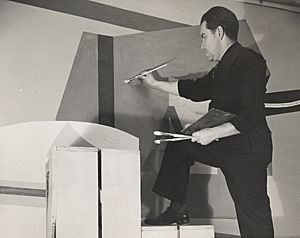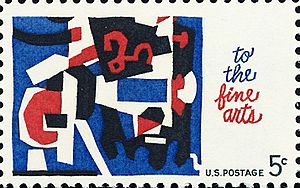Stuart Davis (painter) facts for kids
Quick facts for kids
Stuart Davis
|
|
|---|---|

Davis at work, 1939
|
|
| Born |
Edward Stuart Davis
December 7, 1892 |
| Died | June 24, 1964 (aged 71) New York City, US
|
| Movement | American modernism |
Edward Stuart Davis (December 7, 1892 – June 24, 1964) was an important early American modernist painter. He was famous for his bright, colorful paintings from the 1940s and 1950s. These works were inspired by jazz music and even hinted at pop art before it became popular. In his earlier years, he also created art in the Ashcan School style.
Stuart Davis believed his art could help change society. His political ideas were clear in all his paintings, even the most abstract ones. Unlike many other modernist artists, Davis always stuck to his beliefs through his artwork. By the 1930s, he was a well-known American painter. However, the Great Depression affected him too. This led him to be one of the first artists to join the Federal Art Project.
Contents
Stuart Davis: Early Life and Art Journey
Stuart Davis was born in Philadelphia on December 7, 1892. His father, Edward Wyatt Davis, was an art editor for The Philadelphia Press. His mother, Helen Stuart Davis, was a sculptor. In 1909, Stuart started high school but soon left to study art in New York City.
He began his art training in 1909 under Robert Henri. Henri was the leader of the Ashcan School of art. Davis studied at the Robert Henri School of Art until 1912. During this time, he became friends with other painters like John Sloan, Glenn Coleman, and Henry Glintenkamp.
Discovering Modern Art
In 1913, Davis was one of the youngest artists to show his work at the famous Armory Show. He displayed five watercolor paintings in the Ashcan School style. At this show, Davis saw art by many famous artists. These included Vincent van Gogh, Henri Matisse, and Pablo Picasso. This experience changed his art forever.
Davis became a dedicated "modern" artist. He was a key supporter of cubism and modernism in America. He spent his summers painting in Gloucester, Massachusetts. He also took painting trips to Havana in 1918 and New Mexico in 1923.
Developing a Unique Style
After trying out styles from the Armory Show artists, Davis began to find his own unique way of painting. This started with his 1919 Self-Portrait. In the 1920s, he developed his mature style. He painted abstract still lifes and landscapes. He often used everyday items as subjects, like cigarette packs and spark plug ads. This showed a hint of pop art in his work before it was widely known.
Davis often used parts of his older paintings in new ones. For example, scenes from Gloucester harbors appeared in many later works. He also liked to paint in series. This meant he would create several works with similar shapes but different colors or added designs. It was like creating variations on a musical theme. Some people think this was inspired by his love for jazz music. In jazz, musicians improvise on a basic tune.
Art and Social Change
In 1928, Davis traveled to Paris, France, for a year. There, he painted street scenes. In 1929, he married his American girlfriend, Bessie Chosak, while still in Paris. In the 1930s, he became more involved in politics. He wanted to connect abstract art with ideas about society and industry.
In 1934, he joined the Artists' Union and later became its president. In 1936, he was elected National Secretary of the American Artists' Congress. He painted murals for the Federal Art Project of the Works Progress Administration. These murals were often influenced by his love of jazz.
In 1932, Davis created a mural for Radio City Music Hall. The art committee named it "Men Without Women". However, Davis was not happy with where the mural was placed or its title.
In 1938, Davis painted Swing Landscape. This modernist mural is now seen as one of the most important American paintings of the 20th century. That same year, Davis married Roselle Springer. Later in his life, Davis taught art at the New York School for Social Research and at Yale University.
Besides painting, Davis also made prints. He was a member of the Society of American Graphic Artists. From 1945 to 1951, Davis worked on The Mellow Pad, an abstract painting inspired by jazz.
In 1964, the U.S. Postal Service released a stamp featuring Davis' painting 'Detail Study for Cliche'. Stuart Davis passed away from a stroke in New York on June 24, 1964, at the age of 71.
Influences on Stuart Davis's Art
Robert Henri: His First Teacher
Stuart Davis's first art teacher was Robert Henri. Henri was an American realist painter. He started teaching Davis in 1909. Henri did not think highly of the art schools at the time. This led him and other artists to create their own art shows. Henri encouraged Davis and his other students to find new ways to express themselves. He told them to find inspiration in their daily lives.
Finding Inspiration
During the Progressive Era, Stuart Davis felt very proud to be American. This led him to create several artworks about a "Great America." After studying with Henri, Davis would walk around New York City to find ideas for his art. Being among the public helped him develop a strong social conscience. His friendship with John Sloan, another artist who challenged traditional art, also strengthened this.
Davis often visited the 1913 Armory Show, where his own work was displayed. He used this as a chance to learn more about modernism. He learned how to use the new shapes and colors of European modern art in his own work. This was something Henri had not focused on. In 1925, the Société Anonyme held an exhibit in New York. It featured works by the French artist Fernand Léger. Davis greatly respected Léger. Like Davis, Léger wanted his art to be very clear and precise. Davis also liked Léger's subjects, such as storefronts and billboards.
Where to See Stuart Davis's Art
Stuart Davis's artwork can be found in many public art collections. Here are a few places where you can see his paintings:
- Addison Gallery of American Art (Andover, Massachusetts)
- Amon Carter Museum of American Art (Texas)
- Art Institute of Chicago
- Brooklyn Museum (New York City)
- Cleveland Museum of Art
- Metropolitan Museum of Art (New York City)
- Museum of Modern Art (New York City)
- National Gallery of Australia (Canberra)
- Smithsonian American Art Museum (Washington, D.C.)
- Whitney Museum of American Art (New York City)
- Yale University Art Gallery (Connecticut)
Selected Works
-
Garage No. 1, 1917, Hirshhorn Museum and Sculpture Garden, Washington, DC.
-
Lucky Strike, 1921, Museum of Modern Art, New York City
-
Steeple and Street, 1922, Hirshhorn Museum and Sculpture Garden, Washington, DC.
See also
 In Spanish: Stuart Davis para niños
In Spanish: Stuart Davis para niños
- Precisionism
- The Masses
- The Liberator
- New Masses






